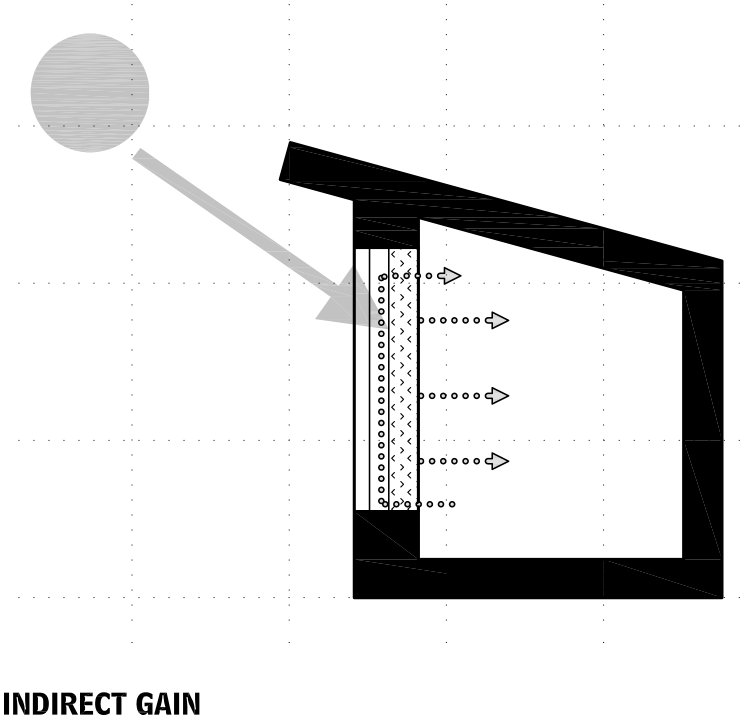Climate control systems (solar heating/cooling systems) may be classified as either active or passive in nature. Passive systems use no purchased energy resources; normally are assembled of “architectural” building elements doing double duty, such as glazings, walls, floors, and finishes; and require design coordination. Cooling, for example, can include induced air precooled from the earth’s mass using air-to-earth heat exchangers (“coolth” tubes) or cooling ponds. Systems can be combined depending on thermal needs. Active climate control systems use purchased energy resources and employ task-specific, single-purpose elements, such as pumps, fans, ducts, and diffusers. Although mechanical engineers usually design HVAC systems, they must coordinate with the entire project.
Passive Solar Heating
A passive solar heating system can displace all, a substantial part of, or some portion of annual heating demands—depending upon system design and project climate. Even where a passive heating system cannot reasonably handle all heating needs—necessitating installation of a backup active heating system—the passive system can contribute to efforts to reach net‐zero energy status without the installation of a larger‐than‐necessary PV or wind system and, perhaps more importantly, reduce carbon emissions related to building heating. There are three basic passive heating system configurations: direct gain, indirect gain (see image below), and isolated gain. A direct gain system is essentially south‐facing glazing coupled with interior thermal mass and with appropriate solar and heat loss control mechanisms. There are three distinct forms of indirect gain systems: Trombe walls, water walls, and roof ponds. Isolated gain systems typically take the form of a sunspace.

Passive Solar Cooling
A passive cooling system uses an exterior condition (such as dry‐bulb air temperature, soil temperature, or night sky temperature) as a heat sink where heat from a building interior can be dumped. As opposed to a passive heating system that obtains substantial heat flow from one source—solar radiation—passive cooling systems typically seek appropriate heat sinks in the face of challenging exterior conditions. The capacity of most heat sinks is inversely proportional to cooling demands—the greater the need for cooling, usually the lower the capacity of passive cooling systems. Nevertheless, a passive cooling system can reduce climate control energy consumption and carbon emissions associated with space cooling.
Passive vs. Active Climate Control Systems
Climate control systems are fundamentally either active or passive. Passive systems use no purchased energy resources, normally are assembled of “architectural” building elements doing double duty (such as glazings, walls, floors, finishes), and require design coordination. Active climate control (HVAC) systems use purchased energy resources and employ task‐specific, single‐purpose elements (such as pumps, fans, ducts, and diffusers).
Thermal Storage Walls, Ground-Source Hat Pumps, and Other Passive Elements
Thermal Storage Walls
A thermal storage wall is a mass wall, usually masonry, located directly behind solar glazing (facing the equator), according to 2030 Palette. The wall and solar glazing area should be sized as a percentage of the floor area to be heated, based on the latitude and corresponding climate. The color of the wall may also be different based on the usable space and the presence of a convective connection.
Ground-Source Heat Pumps
Also called a geothermal heat pump (GHP), GeoExchange, earth-coupled heat pump, or heat source, ground-source heat pumps have been in use since the late 1940s, per the U.S. Department of Energy. They use the constant temperature of the earth as the exchange medium instead of the outside air temperature.
There are several types of ground-source heat pumps: closed-loop, horizontal, vertical, pond/lake, open-loop, and hybrid, but all of them work off the same basic premise:
“Although many parts of the country experience seasonal temperature extremes—from scorching heat in the summer to sub-zero cold in the winter—a few feet below the earth’s surface the ground remains at a relatively constant temperature. Depending on latitude, ground temperatures range from 45 °F (7 °C) to 75 °F (21 °C). Like a cave, this ground temperature is warmer than the air above it during the winter and cooler than the air in the summer. The GHP takes advantage of this by exchanging heat with the earth through a ground heat exchanger.”
As with any heat pump, geothermal and water-source heat pumps are able to heat, cool, and, if so equipped, supply the house with hot water.
Thermosiphon
Natural convection systems rely on the rise and fall of heated and cooled elements such as air. As temperatures change, air moves without mechanical assistance. When the sun warms a collector surface, warm air rises. Simultaneously, cooler air is pulled from the storage bottom, causing a natural convection loop. Heat is convected into the space or stored in the thermal mass until needed.
Coolth Tubes
Coolth tubes are a component of isolated systems in passive solar design. Heat gain or loss occurs away from the weatherskin in these systems, and cooling can include air precooled from the earth’s mass using air to earth heat exchanges such as coolth tubes or cooling ponds.
These and other considerations are now explored with AGS Online, “Passive Solar Heating and Cooling Systems.” The online update provides a good introduction into the alternative system options for passive energy systems. Additionally, this topic includes design limitations, components of passive solar systems, and conceptual graphic illustrations for the architect to consider.

